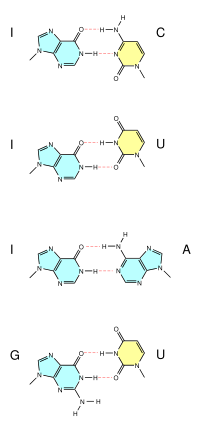 | A base pair (bp) is a fundamental unit of double-stranded nucleic acids consisting of two nucleobases bound to each other by hydrogen bonds. They form... 32 KB (3,677 words) - 10:59, 1 December 2023 |
 | A Hoogsteen base pair is a variation of base-pairing in nucleic acids such as the A•T pair. In this manner, two nucleobases, one on each strand, can be... 8 KB (1,007 words) - 02:31, 29 June 2023 |
the new bond formed between the base and the proton is shown by an arrow that starts on an electron pair from the base and ends at the hydrogen ion (proton)... 13 KB (1,298 words) - 00:59, 6 February 2024 |
Non-canonical base pairs are planar hydrogen bonded pairs of nucleobases, having hydrogen bonding patterns which differ from the patterns observed in... 88 KB (11,728 words) - 20:32, 6 February 2024 |
 | Nucleotide (section Unnatural base pair (UBP)) oriented in opposite directions, which permits base pairing and complementarity between the base-pairs, all which is essential for replicating or transcribing... 32 KB (3,299 words) - 12:22, 17 April 2024 |
 | Nucleic acid analogue (redirect from Base analog) among other things, different base pairing and base stacking properties. Examples include universal bases, which can pair with all four canonical bases... 48 KB (5,268 words) - 21:53, 2 March 2024 |
 | Chargaff's rules (redirect from Base-pairing rules) percentage base pair equality: A% = T% and G% = C%. The rigorous validation of the rule constitutes the basis of Watson–Crick base pairs in the DNA double... 19 KB (2,014 words) - 22:06, 8 April 2024 |
 | Nucleobase (redirect from Nitrogenous base) building blocks of nucleic acids. The ability of nucleobases to form base pairs and to stack one upon another leads directly to long-chain helical structures... 14 KB (1,374 words) - 15:12, 30 January 2024 |
Pairing-based cryptography is the use of a pairing between elements of two cryptographic groups to a third group with a mapping e:G1×G2→GT{\displaystyle... 7 KB (852 words) - 04:40, 19 February 2024 |

